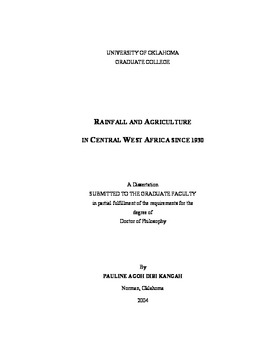| dc.contributor.advisor | Lamb, Peter J., | en_US |
| dc.contributor.author | Dibi Kangah, Pauline Agoh. | en_US |
| dc.date.accessioned | 2013-08-16T12:19:31Z | |
| dc.date.available | 2013-08-16T12:19:31Z | |
| dc.date.issued | 2004 | en_US |
| dc.identifier.uri | https://hdl.handle.net/11244/781 | |
| dc.description.abstract | Rainfall is critical in determining agricultural output. Most farming systems and many aspects of crop growth are adversely affected by rainfall variability, which can have a disproportionate impact because individual crops are affected differently. Agriculture is the main mode of employment; thus, the socioeconomic well-being of Central West Africa relies on crop cultivation, which heavily depends on the vagaries of rainfall. | en_US |
| dc.description.abstract | Subsaharan West African rainfall is highly variable. This variability is related to changes in the tropical Atlantic sector and circulation regimes that alter the preferred location of tropical convection along with the Intertropical Convergence Zone (ITCZ). Rainfall variations and their influence on crops need to be assessed. Although many studies have been conducted on the effects of rainfall on agriculture in various parts of the world, few studies have focused on Central West Africa. This study examines rainfall variability and its effects on crops, societies, and economies of Mali, Burkina Faso, and Cote d'Ivoire. | en_US |
| dc.description.abstract | Studies are conducted and conclusions drawn using descriptive statistics (i.e., mean and standard deviation), Principle Component Analysis, time series, and correlation analyses as well as mapping/graphing analyses in GIS, software packages (e.g., Excel, Systat, Instat, Surfer), and comparisons with successive environmental policies. The results suggest that rainfall variations adequately account for more of the crop output than do environmental policies. It is concluded that the main influence on agriculture is rainfall and so, crop yields revolve mainly around the occurrence/non-occurrence (i.e., availability) of rains. Consequently, the understanding of rainfall variability and its induced agricultural changes is a necessity for sustainable socioeconomic development in Mali, Burkina Faso, and Cote d'Ivoire. This study recommends that environmental policies should acknowledge the importance of seasonal rainfall forecasts and incorporates the climate aspects (i.e., agroclimatologic challenge) into agricultural productivity. | en_US |
| dc.description.abstract | This analysis also investigates rainfall/crop yield relationships. The temporal focus is on recent decades spanning 1930--1998; adjustments are made, as the lengths of available data require. The aim is to determine whether rainfall fluctuations are associated with changes in crop productivity. Additionally, this study of rainfall/crop yields helps to better understand the environment, society, and economy of Central West Africa. | en_US |
| dc.format.extent | xviii, 283 leaves : | en_US |
| dc.subject | History, African. | en_US |
| dc.subject | Economics, Agricultural. | en_US |
| dc.subject | Crop yields Africa, West. | en_US |
| dc.subject | Agriculture Africa, West. | en_US |
| dc.subject | Rain and rainfall Africa, West. | en_US |
| dc.subject | Geography. | en_US |
| dc.title | Rainfall and agriculture in Central West Africa since 1930. | en_US |
| dc.type | Thesis | en_US |
| dc.thesis.degree | Ph.D. | en_US |
| dc.thesis.degreeDiscipline | Department of Geography and Environmental Sustainability | en_US |
| dc.note | Source: Dissertation Abstracts International, Volume: 65-08, Section: A, page: 3111. | en_US |
| dc.note | Adviser: Peter J. Lamb. | en_US |
| ou.identifier | (UMI)AAI3143541 | en_US |
| ou.group | College of Atmospheric & Geographic Sciences::Department of Geography and Environmental Sustainability | |
